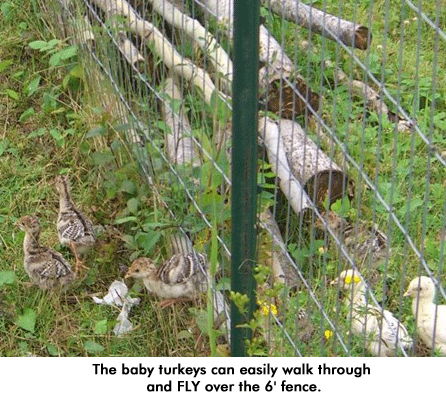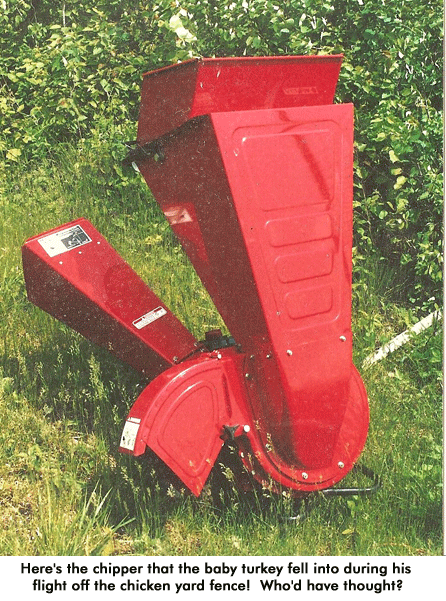Will went out to do chores this morning and counted baby turkeys. There were only eight! We’ve been seeing mama fox and her half-grown babies quite near the buildings, so we just assumed that finally she’d gotten brave and snatched one of the babies, who are now ranging all over, even though we clipped the mother turkey’s wings so she can’t fly over the fence anymore.
All day we were going about with a drooping lower lip. Will and David caught the turkeys and put them into the little chicken coop so “the fox” wouldn’t get them all. (It’s interesting to note that the little turkeys fly over a 6′ fence now! Talk about self-reliant buggers!)
Well at chores tonight Will kept hearing a peeping from around the chicken coop fence. But it sounded like a turkey poult. He looked and looked and couldn’t find the source. Finally, it dawned on him; the chipper sat there with the bin open to the top. And way down inside was the turkey baby! Evidently, it had flown over the 6′ high chicken pen fence and landed in the bin, falling to the bottom. We were VERY happy to see him, and I think he was glad to be rescued and put with his mother.
So we are all happy tonight and the fox family is back in good graces again.
Readers’ Questions:
Canning tomatoes with blight
With all the rain we have had this summer our tomatoes have blight. Researching on line indicates we shouldn’t can them after cutting off the bad spots but can you cut off the bad spots and make spaghetti sauce or something else and freeze it or should we just let them go?
Charles Wiedmaier
Mondovi, Wisconsin
I just cut the bad spots off and can ’em. I know some of the canning books say “only sound fruit,” but that’s kind of protecting dummies from canning rotten fruit, I think. I won’t tell YOU to cut off your bad spots, but only that that is what I do. — Jackie
Canning corned beef
Is it possible to can corned beef that I get from the deli rather than making it from scratch and canning it? Would I just heat the corned beef up in water after I chunk it and then finish the process in a pressure canner?
Nita Holstine
Hawley, Texas
Yes. I would make my chunks an inch thick, as thicker chunks might possibly not heat thoroughly into the center. Pack your jars with your chunks, leaving 1″ of headspace, then pour in the water you boiled it in, leaving 1″ of headspace. It will finish “cooking” in the canner. Process pints for 75 minutes and quarts for 90 minutes at 10 pounds pressure. If you live at an altitude above 1,000 feet, consult your canning book for directions on increasing your pressure to suit your altitude, if necessary. — Jackie
Canning previously frozen beans
I was wondering if I could can green beans previously frozen. I had a bunch of beans and a short amount of time so just blanched them and froze them. I would now like to get them out of the freezer so wondered if I could can them? Pressure of course. Frozen or thawed/cooked?
Katherine Jordahl
Fergus Falls, Minnesota
Yes, you can home can frozen green beans. Thaw them out, bring them to boiling, then ladle in your jars, as if they were fresh and process for the same time and pressure as if they were fresh. — Jackie
Tomato juice canning tip
Tip for making pizza or spaghetti sauce: For thicker tomato juice before cooking down, put juice in blender, blend very well, let juice set for 20 minutes or as long as possible (overnight in fridge). Set pot on corner of something to let water collect at the low point. Use turkey baster to suck water from bottom of pot. Use a fine screen pot skimmer (pampered chef makes one that is perfect) to skim thicker juice from top into another pot, do not stir. If you do NOT use the blender, the water rises to the top. If you use the blender, the water goes to the bottom and releases 2 or 3 times more water.
Hard water stains on canning jars, add 1/4 cup vinegar in canning water during processing, jars come out cleaner plus pressure canner or waterbath canner is cleaner also.
Michael Armstrong
Little Hocking, Ohio
Thanks for the tips Michael. I use the vinegar in my canners, as we do have hard water too. — Jackie
Heating canned meats before serving
How long should you heat your canned meats before serving?
Betty Anderson
Berryville, Arkansas
You should heat all low acid foods, including meat, to boiling temperature, for 10-15 minutes before eating. This may be boiling, baking, roasting, or whatever method you choose to make them safe, should there be any possible bacterial contamination. — Jackie
Planting cole crops
Thank you so much for the answer to the reader whose broccoli was not producing. Mine wasn’t either. When I pulled up the short, dying plant the roots were still square from the container. After pulling them all up the only semi-decent root ball was from the one which was crushed soon after planting. I also pulled up the non-growing chard which was also root bound. I’ll try planting some seeds to see what happens.
Julia Crow
Gardnerville, Nevada
This happens a lot. It’s best to grow your own plants, planting the seeds of cole crops only a month before you want them in the garden. That way, they don’t get root bound. The ones in the stores are often way older than that. They look great in the nursery, but just don’t produce. On the homestead, production is our top priority. If you do plant “store” plants, buy ’em early, buy small, vigorous ones and “squish” the root ball to separate the roots before planting. — Jackie
Saving bean seeds
First of all, we’d like to thank you very much for suggesting Kentucky Wonder beans when we asked! They are doing amazing! The question we have relates to them in that we’d like to try to save some seeds (they are heirloom and organic) but we’ve never done that and aren’t sure what to do.
Tracy & Bill
Kenmore, New York
I’m glad you like Kentucky Wonders. They are a valued heirloom for good reason! They are easy to save seeds from. Simply let a portion of your row of beans “go”; don’t pick any more beans from them. The beans in the pods will soon get fat, then the pods will begin to dry. When the pods get very dry and tan, the seeds will be mature. Open a couple pods to make sure the seeds are, indeed, dry. If not, let them go awhile longer. Then just pick the pods and thrash out the bean seeds. I’d let them dry awhile longer on a pan in a dry location, then store them in an airtight container. You will have now completed the circle. Your next year’s bean seeds are right in your hand! — Jackie
Storing acorn squash
How do we store acorn squash?
Rat Jenkins
Coal City, Illinois
Of nearly all winter squash, acorn squash is the shortest storage squash. Squash likes to be stored at cool room temperature; it lasts for a shorter time in a cold root cellar. You can expect acorn squash to last until early-mid winter if you’re lucky. When you pick it, pick it with the stems on, and only store the ripe, unblemished fruit. You might consider trying a longer storing squash next year, such as Hubbard, Hopi Pale Grey, or Kubocha. Even Atlantic Giant pumpkins store a long time. For an experiment I kept one we raised last year, and it is STILL rock hard, laying on the floor of our addition! Wow! — Jackie
Storing honey
Is there anyway to can or preserve honey for long term storage?
John Bull
Everett, Washington
Luckily, honey is a near perfect food. It will remain good for decades with no special treatment. If you pour hot, liquid honey into hot jars, leaving 1/4″ of room at the top of the jar, then wipe the rim off and put a lid and ring on it, This honey will store for a long, long time. If it should get solid, due to cold, simply warm up a jar when you want to use it. It will re-liquefy and be ready to eat. — Jackie





Jackie,
Glad to see you are getting around and that your little turkey poult was okay. On your suggestion in various posts, I planted Hopi Pale Grey squash this year. They started off kind of slow until monsoon season hit. Now, WOW! They have taken off all over the yard and are the biggest and strongest squash I’ve grown. Squash is still forming, but it looks like I’ll have enough for a few good feeds this year. It’s a good thing that I only planted 3 seeds. The HPG are planted at 4,000 feet in S.E. Arizona, so I guess they like being close to “home”.
Thanks for the great advice over the years.
Matt
Comments are closed.